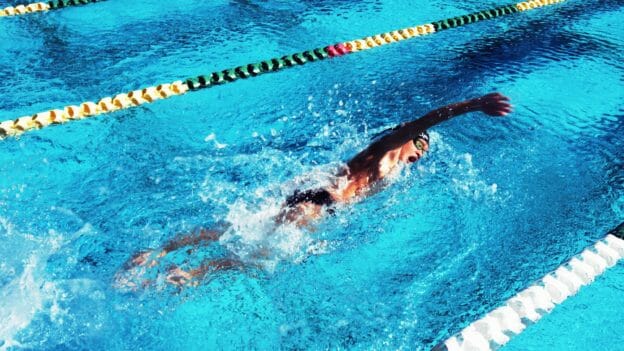The Art of Breathing in Swimming Part III
In part II of this series, we discussed where and how to breathe in freestyle and butterfly, but the question that remains is ‘how often should we breathe in swimming’? In the first article we established that, for the most part, swimmers train hypoxically. In other words, they don’t breathe quite as often as they would if they could breathe at will. Further, we know that depriving swimmers of oxygen by training at altitude significantly improves all of the aerobic systems involved in the production of ATP. While training hypoxically may make sense for most swimmers, racing hypoxically in any event other than a 50-meter sprint does not. After about 20 seconds of near maximal exertion, we must rely on both aerobic and anaerobic systems of energy production to keep going. Bring on the oxygen!
Since the respiratory rate that seems to work most efficiently on land during maximal exercise is 50-60 breaths per minute, we must assume that the ideal respiratory rate for a swimmer racing should be similar. In freestyle, if we consider that breathing every cycle (every other stroke) is the most often we can breathe, then a stroke rate of at least 100 is needed to achieve that respiratory rate. In shoulder-driven freestyle, that is often the stroke rate we see among elite swimmers in the 100 freestyle. The hybrid freestylers, such as Phelps, Lochte or Lezak, may drop down to the mid 80’s, leading to a respiratory rate lower than the ideal.
In the 1500 meter freestyle, particularly on the men’s side, we find an interesting variety of freestyle techniques with substantially different stroke and respiratory rates. World record holder Sun Yang uses a hip-driven technique with a stroke rate of 60 for most of the race. If he used a conventional one-breath per cycle breathing pattern and without considering the turns, that would mean a very low respiratory rate of 30 per minute, but he doesn’t. In the middle of most laps and going into and out of each turn, Sun Yang takes a breath to each side in succession, breathing three or even four strokes in a row. Those extra three or four breaths per length likely have a huge impact on his ability to sustain his speed and finish faster than any other swimmer in the race.
Comparing Sun Yang’s breaths in the 1500 to Ryan Cochrane from Canada, who uses a shoulder driven freestyle technique with a stroke rate of 86, here is what we find. Ryan breathes every third stroke for the first 800 meters or so, then switches to every cycle for the final 700 meters. So for approximately half of the race, Ryan’s respiratory rate is around 28 and for the other half it is 43. If we consider the race to be 15 minutes of duration, that means that Ryan would be getting around 532 breaths. With four extra breaths per length, Sun Yang would be getting around 570 breaths, even with a stroke rate of 60 compared to Ryan’s 86.
Connor Jaeger and Katie Ledecky both swim the 1500 with a hybrid technique and a similar stroke rate of around 86, breathing every cycle. Over 15 minutes of sustained swimming at this rate, they each would have around 645 breaths, more than Sun Yang or Ryan Cochrane.
I am not sure what conclusion we can draw from this, except that both Sun Yang and Ryan Cochrane modify their traditional breathing patterns in order to get more oxygen delivery. Perhaps in the future, we will see more swimmers modify their breathing patterns to get more oxygen delivery by breathing to both sides or abandoning the 1:3 pattern of breathing like Ryan begins the race with.
In the butterfly, there is a growing trend, particularly on the men’s side, toward breathing every stroke for both the 100 and 200 meter events. In the 100 meters, with stroke rates typically in the mid 50’s, that would be very close to the ideal respiratory rate. In the 200, with stroke rates usually in the mid to high 40’s, the respiratory rate breathing every stroke is less than ideal, but not far from it. However, if one breathes every other stroke in fly, in either event, the respiratory rate drops down into the 20’s, which is far from ideal.
It is no wonder that the fastest finishers in the fly are typically the swimmers breathing every stroke. The key points to breathing more are to practice the breathing pattern to be used in races often, develop the ability to get the breath quickly and with the least amount of disruption to the stroke cycle or increase in frontal drag, and to use the kinetic energy of the head drop or head turn as a coupling motion to augment the propulsive forces of the hands and feet. The last point is really what I call ‘using your head’.
Remember, oxygen is the most important nutrient we have, so I say, ‘Let’s get more of it, not less’. Besides that, it is lot more fun to pass people at the end of a race, rather than being the one who is passed.
Yours in swimming,
Gary Sr.
Read How Oxygen Affects Our Bodies in a Swim Race: The Art of Breathing in Swimming Part I
Read How to Inhale and Exhale While Swimming Fast: The Art of Breathing in Swimming Part II

